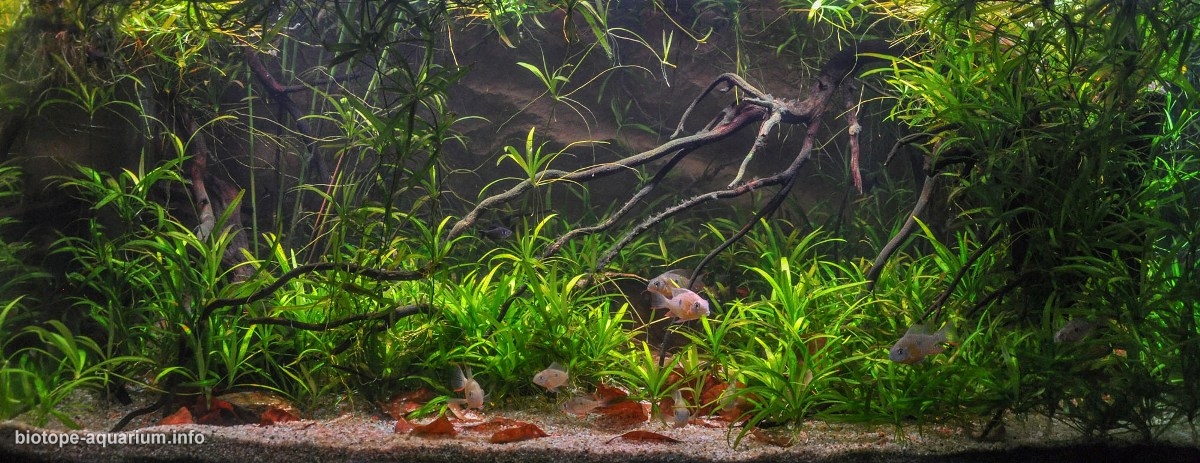Costal area in Itenez, Bolivian Guapore
58th place in Biotope Aquarium Design Contest 2019
Romania. Emil Visan

Volume: 330 L
Dimensions: 120x55x50 cm
List of fishes: Microgeophagus altispinosa, Megalamphodus megalopterus
List of plants: Helanthium bolivianum v. quatricostatus, Pistia stratiotes, Cyperus sp.
Description of decorations: 1-2 mm sand, rocks of the river, roots and branches, dried leaves.
Description of equipment: Background: 3d Homemade. Lighting: led lamp. Filtration: Eheim 224+ internal filter 800l/h.
Water parameters: Temp: 24 deg. Celssius; pH 6,3; GH 2; TDS=30
Additional info: –
INFORMATION ABOUT BIOTOPE
Description of the area surrounding the biotope: Guaporé River (Portuguese: Rio Guaporé) is a river in western Brazil and northeastern Bolivia. Its Bolivian name is Río Iténez. It is 1,530 km (950 mi) long; 970 km (600 mi) of the river forms the border between Brazil and Bolivia. The Guaporé River is part of the Madeira River basin, which eventually empties into the Amazon River. The Guaporé River crosses the eastern part of the Beni savanna region.It forms the border of the 615,771 hectares (1,521,600 acres) Guaporé Biological Reserve, and is fed by rivers originating in the reserve, the São Miguel, Branco, São Simão, Massaco and Colorado. Unlike other rivers in the Madeira system it’s a “clearwater” right bank tributary to the Rio Mamore and drains the eastern Bolivian lowlands and southern Brazilian Shield. It originates in the Mato Grosso Plateau, Brazil and therefore variety of flora and fauna is similar to those found in the Pantanal wetlands region. Extensive areas of seasonally flooded forests and savannas, swamps, marshes, and shallow, flat-bottomed lakes creates a unique ecosystem with variety of specialized habitats. Whole area is extremely rich in flora and fauna species. Literature says there is about 600+ different fish species in Itenez drainage. Some people call Rio Guapore the most rich river in aquatic plants all over the South America.
Description of the underwater landscape of the biotope: The biotope specified in the aquarium has a shallow edge, with a water level of approx. 50cm. This type of coastal area is full of submerged aquatic plants during the rainy season, and partially or totally emerged when the rains do not fall. The slow movement of water in the oxbow area, where the flow has been stronger in the past, and the roots of inlaid trees occur, creates a perfect microhabitat for small species groups. The thick layer of dead leaves, twigs and bark gives hidden spots and varieties of food sources for these species. This area is also covered with Cyperus sp on the shore, then with Echinodorus such as Echinodorus Quatricostatus, so it is well-shaded and therefore creates a safe environment for small fish, the Hyphessobrycon Group, while looking for food, it moves to the front of the roots in the area with brighter light, which provides perfect conditions for the Helanthium species to grow densely. At the bottom the specimens of Microgeophhagus altispinosus dispute their territories.
Description of the parameters of the habitat: Water parameters varies depends of specific habitat, but water is almost crystal clear (small amount of tannins occur in the forest areas), soft and slightly acidic with parameters: pH 6,0-6,8; hardness 1 ºdH; electrical conductivity 5-20 µS/cm (to 100µS/cm in the seasonally almost drying lakes and oxbows), temperature 22-28 ºC.
List of fishes and invertebrates occurring in the nature biotope: Aphyocharax sp., Hemigrammus sp., Gymnocorymbus sp., Hyphessobrycon sp., Corydoras sp., Otocinclus sp., Apistogramma sp. and many more.
List of plants found in the nature biotope: Eichhornia azurea, Echinodorus sp. (many species), Ludwigia sp., Cabomba furcata, Myriophyllum sp., Hydrocotyle leucocephala, Egeria najas, Salvinia auriculata, Pistia stratiotis,Cyperus sp. and many more depends of water mark during high and low water levels.
Threats to the ecology: –
Sources of information:
Bleher Biotopes
Catálogo das Espécies de Peixes de Água Doce do Brasil, 2007 (https://www.researchgate.net/
http://www.feow.org/
Chimia diferitelor tipuri de apă amazoniene pentru clasificarea râurilor: o revizuire preliminară, 2014 (https://www.witpress.com/
CATÁLOGO DE LOS PECES DE LA CUENCA ITÉNEZ (BOLIVIA Y BRASIL), dif. autori (https://www.academia.edu/
Peces del Rio Mamore, L. Lauzanne, G. Loubens, Paris 1985
Discussions with other aquarists and enthusiasts around the world
